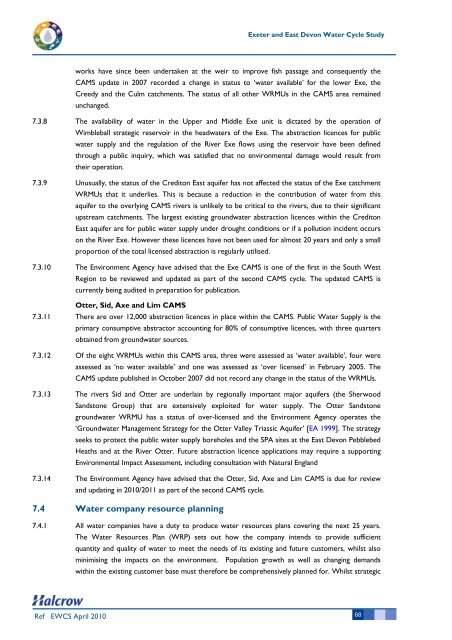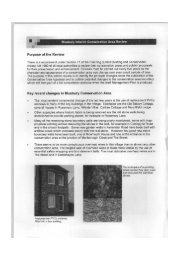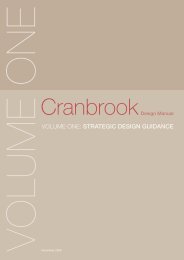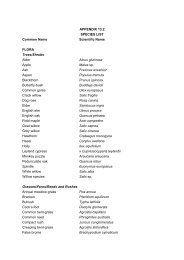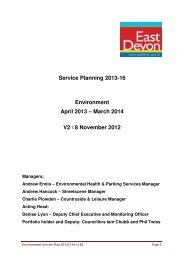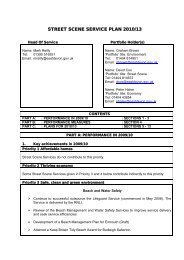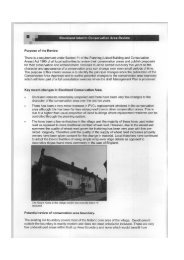Water Cycle Study - East Devon District Council
Water Cycle Study - East Devon District Council
Water Cycle Study - East Devon District Council
You also want an ePaper? Increase the reach of your titles
YUMPU automatically turns print PDFs into web optimized ePapers that Google loves.
Ref EWCS April 2010<br />
Exeter and <strong>East</strong> <strong>Devon</strong> <strong>Water</strong> <strong>Cycle</strong> <strong>Study</strong><br />
works have since been undertaken at the weir to improve fish passage and consequently the<br />
CAMS update in 2007 recorded a change in status to ‘water available’ for the lower Exe, the<br />
Creedy and the Culm catchments. The status of all other WRMUs in the CAMS area remained<br />
unchanged.<br />
7.3.8 The availability of water in the Upper and Middle Exe unit is dictated by the operation of<br />
Wimbleball strategic reservoir in the headwaters of the Exe. The abstraction licences for public<br />
water supply and the regulation of the River Exe flows using the reservoir have been defined<br />
through a public inquiry, which was satisfied that no environmental damage would result from<br />
their operation.<br />
7.3.9 Unusually, the status of the Crediton <strong>East</strong> aquifer has not affected the status of the Exe catchment<br />
WRMUs that it underlies. This is because a reduction in the contribution of water from this<br />
aquifer to the overlying CAMS rivers is unlikely to be critical to the rivers, due to their significant<br />
upstream catchments. The largest existing groundwater abstraction licences within the Crediton<br />
<strong>East</strong> aquifer are for public water supply under drought conditions or if a pollution incident occurs<br />
on the River Exe. However these licences have not been used for almost 20 years and only a small<br />
proportion of the total licensed abstraction is regularly utilised.<br />
7.3.10 The Environment Agency have advised that the Exe CAMS is one of the first in the South West<br />
Region to be reviewed and updated as part of the second CAMS cycle. The updated CAMS is<br />
currently being audited in preparation for publication.<br />
Otter, Sid, Axe and Lim CAMS<br />
7.3.11 There are over 12,000 abstraction licences in place within the CAMS. Public <strong>Water</strong> Supply is the<br />
primary consumptive abstractor accounting for 80% of consumptive licences, with three quarters<br />
obtained from groundwater sources.<br />
7.3.12 Of the eight WRMUs within this CAMS area, three were assessed as ‘water available’, four were<br />
assessed as ‘no water available’ and one was assessed as ‘over licensed’ in February 2005. The<br />
CAMS update published in October 2007 did not record any change in the status of the WRMUs.<br />
7.3.13 The rivers Sid and Otter are underlain by regionally important major aquifers (the Sherwood<br />
Sandstone Group) that are extensively exploited for water supply. The Otter Sandstone<br />
groundwater WRMU has a status of over-licensed and the Environment Agency operates the<br />
‘Groundwater Management Strategy for the Otter Valley Triassic Aquifer’ [EA 1999]. The strategy<br />
seeks to protect the public water supply boreholes and the SPA sites at the <strong>East</strong> <strong>Devon</strong> Pebblebed<br />
Heaths and at the River Otter. Future abstraction licence applications may require a supporting<br />
Environmental Impact Assessment, including consultation with Natural England<br />
7.3.14 The Environment Agency have advised that the Otter, Sid, Axe and Lim CAMS is due for review<br />
and updating in 2010/2011 as part of the second CAMS cycle.<br />
7.4 <strong>Water</strong> company resource planning<br />
7.4.1 All water companies have a duty to produce water resources plans covering the next 25 years.<br />
The <strong>Water</strong> Resources Plan (WRP) sets out how the company intends to provide sufficient<br />
quantity and quality of water to meet the needs of its existing and future customers, whilst also<br />
minimising the impacts on the environment. Population growth as well as changing demands<br />
within the existing customer base must therefore be comprehensively planned for. Whilst strategic<br />
68


